Confectionery
Works, Bake Office, Mary's
Woodbridge Road, 'Confectionery Works'
(Stubbings Sweet Factory – see 2021 update below)
Still trading as Greens* builders merchants when this
photograph was
taken
in March 2000, sadly the building no longer exists. It qualifies as an
example of trade lettering, not because of the 'GREENS' (albeit painted
twice on the frontage, with varying states of distress), nor yet for
the
curiously crooked, yet firmly screwed on 'REGD.
PLUMBER' sign high up
on
the timber yard wall. The secret lettering was just spotted above the
(barely
visible here) gates to the right.
[*Pedants' Corner: it is always interesting to observe the use - or
deliberate omission - of punctuation marks in signs of all sorts; the
stray 'greengrocer's apostrophe' found in e.g. "POTATO'S" and the
apostrophe-lacking shop name shown here suggests that the business was
owned by Mr Greens.]
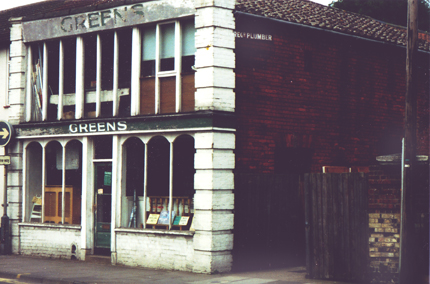

A stool was mounted to get these shots on a sunny
Spring morning in
2003,
balancing over the closed gates. The expected curving word
'CONFECTIONERS'
turned out to have a corollary below it:
'CONFECTIONERY
WORKS'
There is a naively-painted pointing hand (technically
known as a manicule) in white
outline below, which follows the
curve
of 'Confectionery' lettering. 'Works' has an underline in white. The
enhanced image to the right suggests the form and positioning of the
obscured first 'C' and last 'Y' of 'Confectionery'.


This battered old brick wall could have told some
tales. The whole
building
was demolished and removed three weeks after these photographs were
taken
in April, 2003. Clearly a victim of timber and other heavy materials
being
moved in and out, it also bears scars as if scraped by the sides of
carts
in years gone by. Although run down and unimposing in the top
photograph,
the building ran back from the road a long way and had some interesting
features. A sweet-making factory, then - or possibly a baker's making
sweetmeats - but we wonder when and under
whose
proprietorship?

[UPDATE 3.5.2021: 'The Mulberry
Tree Inn has been rebuilt since those days, and it was situated nearer
the highway. It had an ostler's office – a small wooden hut – at the
side entrance. There was plenty of accomodation for horses here. Next
door was Mulberry Tree meadow, the site of Tudor's circus. Before the
circus was housed in a wooden building, it was a tented affair. Mr.
Tudor was the jovial proprietor. But even before Tudor put on his show,
fairs and the like were held...
The Drill Hall, on part of Tudor's site, is now a police garage, and on
the same side a short distance away, was Stubbings Sweet Factory.' Taken from
The East Anglian Magazine,
Sept. 1973, page 527; the article recalled memories of Woodbridge Road
from the late 19th century. This must have been the Confectionery Works
of the sign.]
81 Great Whip Street, Bake Office
visible
from Felaw Street (Felaw Street now has its own page.)
Painted on the end of terrace wall of the
launderette at the
corner of Great
Whip
Street and Felaw Street (close to the refurbished Felaw Maltings, for
so
many years a disintegrating monument of the Industrial Revolution in
Ipswich):
'BAKE
OFFICE'
At first we assumed that this was
the place which dealt
with
the hiring and firing of malsters and workers at the nearby maltings,
until
we saw the period photograph of the premises of E.R.
George, Baker and Pastry Cook. The sign 'Bake Office' is there on
the
wall fronting Crown Street, so a baker's office for taking orders,
then? Chatting with a museum curator of our acquaintance, it is now
clear
that a bake office was a feature of times when fuel of all kinds was
expensive. For a working-class community it became commonplace, once
the early-start
baking had been done, for all that power needed to heat the bread ovens
in bakers' premises to be used by those in surrounding houses to
warm/cook their dinners. One has visions of streets with housewives
rushing back and forth with tureens, hot pots, casseroles and covered
plates of
food. [See UPDATE 15.11.2012 from Carolyn Saxon below.] There were
other bake offices down Wherstead Road serving the surrounding
households but we have been able to find no lettering like this. That
excellent portrait of the life of the poorest in 19th century Ipswich Rags and bones by Frank Grace [see Reading List] mentions that in the St Clement's
parish on the other side of the Wet Dock "twenty-three bake houses were
registered in the area in 1885, nine of which provided 'offices' where
the poor could have their meat or pudding cooked cheaply...".
Again, concerning bake offices in the Potteries area, from Rags and bones:
"[In the 1880s] The bake offices in Ernest Street, New Street and
Pottery Street as well as elsewhere on Fore Street and below, continued
to be popular with the many housewives who could not afford to light
their own stoves.
'... if you hadn't got a big enough oven to cook your meat the baker
would ... I would take mother's Christmas cake up to Dine's up in Eagle
Street and they used to cook the cakes for us. We hadn't got a Regulo
or anything like that ... they'd cook no end of people's stuff, that'd
only be a penny or two pence ... it was cheaper than it was for mother
to cook it in the oven."
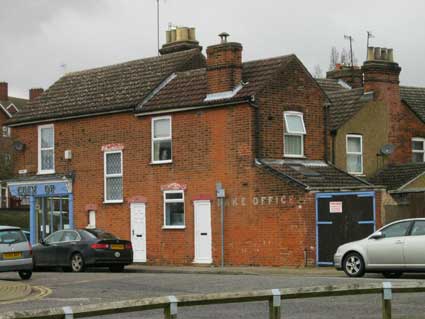
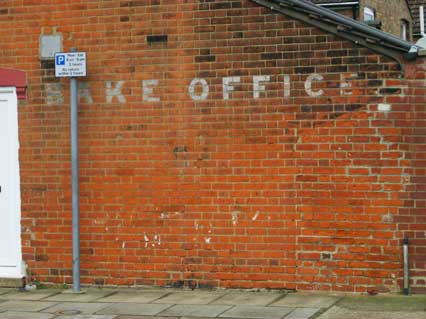 2013 images
2013 images
These almost fetishistic photographs of individual characters
and the texture and colour of the brickwork...
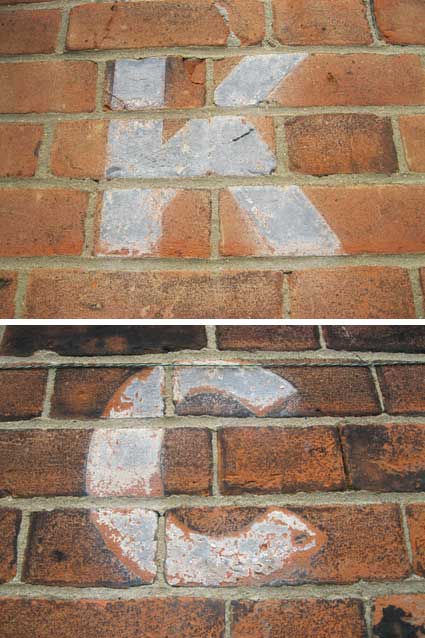
This is only a few yards from one of the 'Wm. Paul Tenement Trust' plaques.
Here is a photograph taken in the 1960s of Felaw Street from the Vernon
Street/Hawes Street corner. The 'Bake Office' sign is visible at the
left (enlargement ringed). At this time Felaw Maltings would have been
in full production of malt using both local barley and grain imported
by ship to land at Stoke Quay close to the maltings. Production ceased
in the early 1980s. By the late 1990s the complex became the Suffolk
Enterprise Centre. The white building with the pitched roof beyond the
maltings has now gone and the area is a small car park.
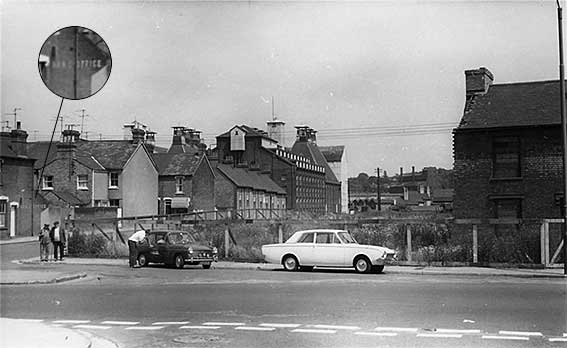 1960s
image courtesy The Ipswich Society
1960s
image courtesy The Ipswich Society
Here's a composite photograph of the corner
of
Great Whip Street and Felaw Street in 2011; the 'BAKE OFFICE' lettering
is towards the end of the red brick wall at the right of the image.
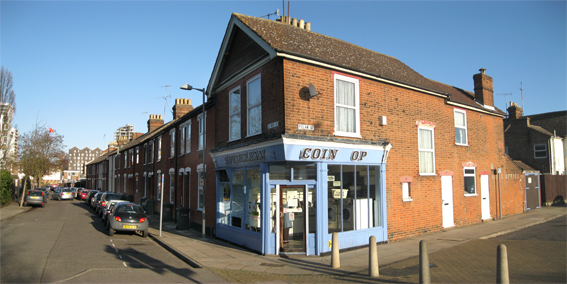 2010
image
2010
image
Between the corner entrance and the 'Bake
Office' lettering is a small window with decorative lintel. The doors
and larger window bear the same, if worn, decoration. Perhaps this
window shed light onto a storage cupboard or scullery.
 2021 image
2021 image
It's only a few hundred yards from the here to The Methodist Mission Room, The Old Bell and the Trinity
House buoy (towards the town) and Uncle
Tom's Cabin and C.J. Hawes shop
(towards Wherstead).
[UPDATE
September 2010: we have unearthed this
photographic detail from the 1960s (below) which is the same building,
the premises at the time of Haward's Bakery - see the 3-D gold-lettered
'Hovis Golden Brown' sign. For 'Hovis' lettering which still exists,
see 111 Bramford Road. Presumably the
surname is pronounced
'Howard' as in the local architect, Birkin Haward. Much of the housing
and shops around this
building were demolished when Vernon Street/Hawes Street were
remodelled, a new roundabout built between them and the upper section
of Wherstead Road ceased to be the through way for traffic. In the
background can be seen (see close-up) the
lettered:
'R(obscured)&W
PAUL LTD'
concrete silo on the upper Wet Dock and over
the bakery roof one of the Felaw Street malting tower vents.]

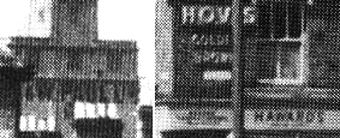 1960s
1960s
[UPDATE 15.11.2012: "On the
corner of Felaw St & Great Whip St stands a launderette. When
I was a child this used to be a bakery. On the Felaw St side is a
painted sign saying Bake Office. I used to live in Tyler
St. My Nana who lived there for many years, told me this was a
bake shop where people could take their food to be cooked for a few old
pennies. Thought it may be of interest on your site... So glad
you had the name of the bakery, I couldn't remember it for the life of
me. Love your site, Carolyn
Saxon." Thanks to Carolyn for
explaining the role of a 'bake
office' in such a personal
testimony.]
[UPDATE 28.12.2012: "... There
was a wonderful smell of freshly baked bread “Over Stoke” .
Mrs. Frances Osborn, of Ipswich said 'My father owned Orwell Bakery in
Stoke Street from 1947 to 1956, he bought the business from a Harry
Burwood, when he retired, he told my father that in the future Belstead
would be joined to Ipswich, which has come true.'
'I used to deliver bread daily to all the local streets in Stoke, Great
and Little Whip Streets, Bulstrode Road, Gower Street, Hawes Street,
Turin Street, and Pauline Street, to name but a few, and going as far
as the local villages.'
'There were three bakeries over Stoke at that time, Howard’s
[sic], Whip Street. Before Howard’s the owner was Day, who
earlier had a bakery in Eagle Street. Before Garrod’s owned
Station Street Bakery, it was owned by Mr. Catton, the last people to
run the bakery were called Jennings. The bakehouse in Station Street
used to deliver bread by pony and cart and a Mr. Hazelton used to work
with the cart, and his sister worked in my parents’ bakers shop,
her name was Elsie. In those days you could buy anything local without
going into town, there was a butchers, shoe shop, babywear, piano shop,
chemist, café, newsagents, greengrocers, furniture shop owned by
Allen & Son, pork shop. In Harland Street there was a lady who used
to tell your fortune. I lived “Over Stoke” from 1947 until
1991, they were good old days...' " These quotations in slightly edited
form are taken from the Kindred Spirit website (see Links).]
See our Felixstowe Road page under 'Royal
Oak House' for another Hawards Bakers shop, the sign briefly revealed
in May, 2018.
The laundrette (former bakery) shown here stands on the site of the
Union Workhouse which had extensive
orchards and gardens running down
to New Cut. For maps of this and the story of Felaw Street and environs
see our Felaw Street page.
Woodbridge Road/St Helens
Church Lane
A few hundred metres up the Woodbridge Road hill from
where the
Confectionery Works once stood, is a shop frontage with no shop, on the
overhang are the relief capitals:
'MARY'S'
painted over in dark green
to
commemorate the hairdresser's which stood at the corner. The door at a
45
degree angle to the street is now bricked up - it's at the top of St
Helen's Church Lane running down to St Helen's Street, also close to
the
main gate to St Helen's Primary School. Through that door one was once
(up until the late eighties?) able to glimpse basins and an array of
those 'space helmet' style hair dryers on stands. Once again this sign
doesn't quite follow the parameters set out in our Introduction, but it's worth
including as an example of the sort of shop sign now becoming rare in
our town [suggested by Ed Broom].
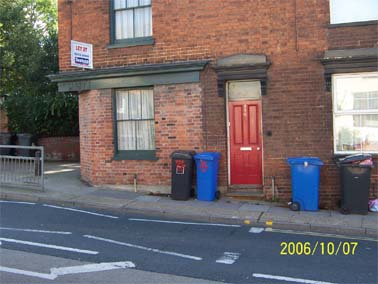 -
-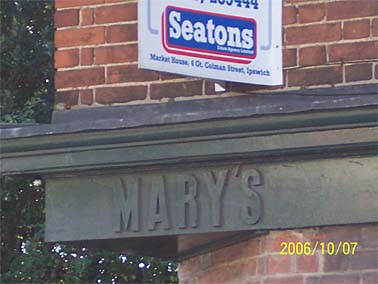 Courtesy Ed Broom
Courtesy Ed Broom
[UPDATE 3.5.2021: 'Back
on the right hand side [of Woodbridge Road, travelling out from the
town], at the top of St. Helen's Church Lane – we have already noticed
the large green conical-shaped ventialtors on the roof of St. Helen's
School from the bottom of the hill – was the grocery shop of William
White. William was proud to remind prospective customers that he served
himself best by being of service to others.' Taken from The East Anglian Magazine, Sept.
1973, page 527; the article recalled memories of Woodbridge Road from
the late 19th century. This must have been the business operating from
this address earlier than Mary's Hairdressing Salon.]
Home
Please email any comments and contributions by clicking here.
Search Ipswich
Historic Lettering
©2004 Copyright
throughout the Ipswich
Historic Lettering site: Borin Van Loon
No reproduction of text or images without express written permission






 2013 images
2013 images
 1960s
image courtesy The Ipswich Society
1960s
image courtesy The Ipswich Society 2010
image
2010
image 2021 image
2021 image
 1960s
1960s -
- Courtesy Ed Broom
Courtesy Ed Broom